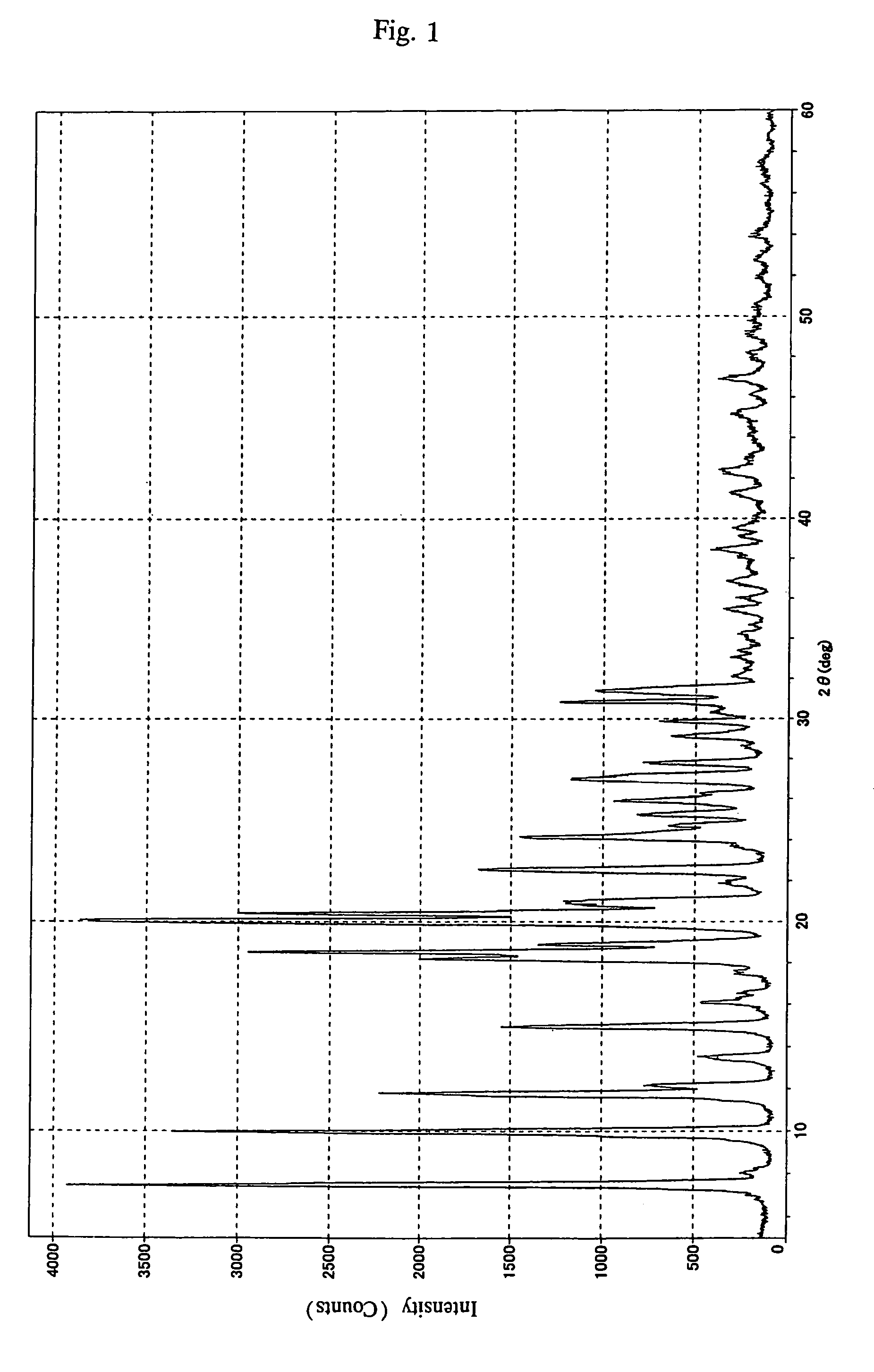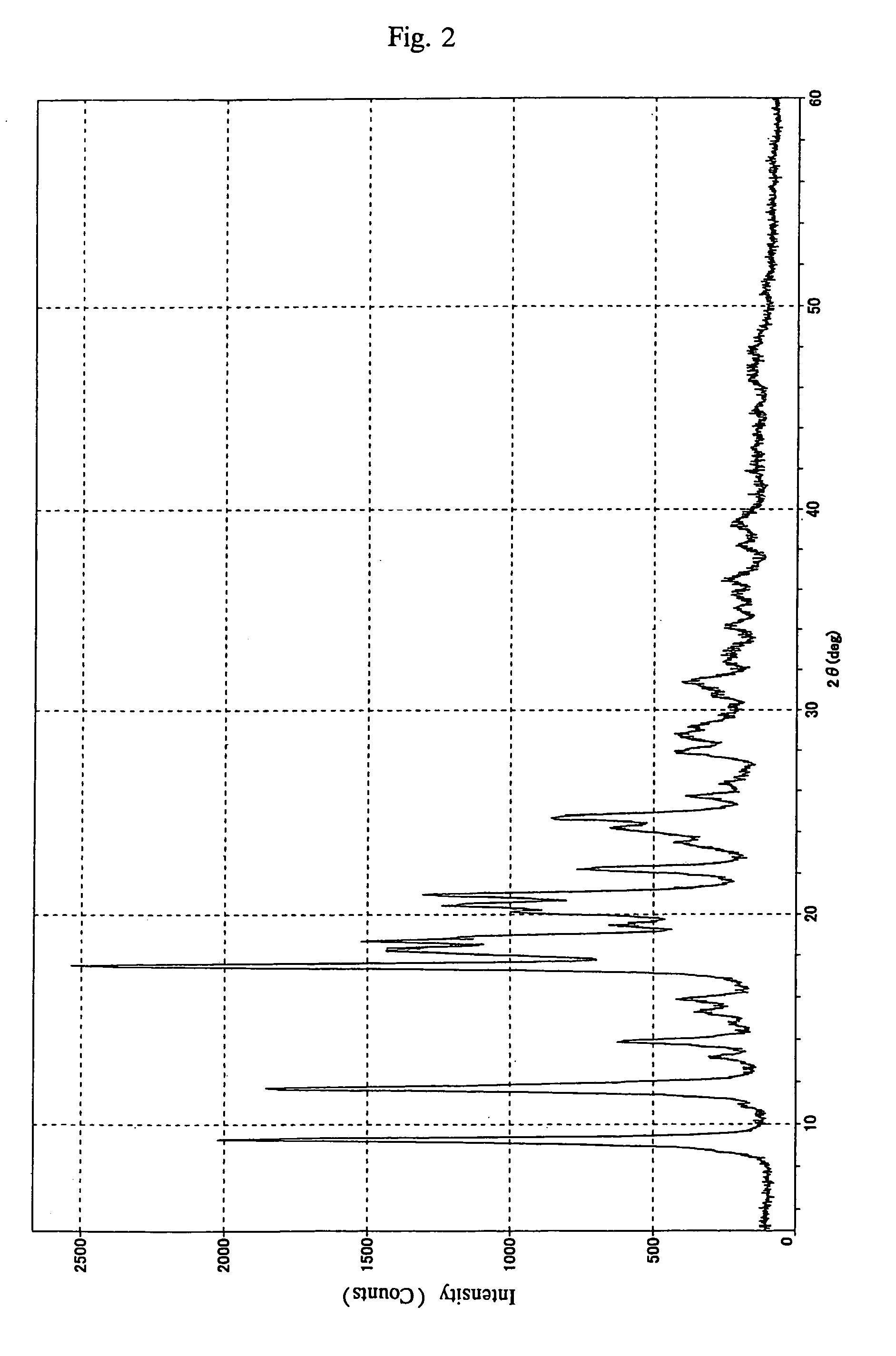Penam crystals and process for producing the same
a technology of penam crystals and penam, which is applied in the field of penam crystals, can solve the problems of low efficiency of separating tmpb from by-products that are simultaneously generated in the reaction, unstable oily or amorphous tmpb, and high cost, and achieves the effects of reducing compatibility with acetone, and reducing the number of acetone-containing compounds
- Summary
- Abstract
- Description
- Claims
- Application Information
AI Technical Summary
Benefits of technology
Problems solved by technology
Method used
Image
Examples
example 1
[0122]A dichloromethane solution (700 ml) containing 43.5 g of 2β-chloromethyl-2α-methylpenam-3-carboxylic acid benzhydryl ester was mixed with 200 ml of 1,2,3-triazole and about 130 ml of an anion exchange resin (“Diaion WA30”, manufactured by Mitsubishi Chemical Corp.), and the mixture was stirred at 40° C. for 3 hours. After the reaction, the anion exchange resin was filtered off, and 200 ml of water was added to the filtrate to separate the dichloromethane layer. The dichloromethane layer thus obtained was washed twice with water, thereby giving 600 ml of a dichloromethane solution. This dichloromethane solution is hereinafter referred to as “dichloromethane solution (1)”. This solution contained 30 g of TMPB.
[0123]Dichloromethane solution (1) was concentrated under reduced pressure (60 to 40 kPa) at 40° C. or lower. When about 450 ml of dichloromethane was removed, 250 ml of acetone was added to the thus-concentrated dichloromethane solution (1). Concentration was continued unt...
example 2
[0133]Acetone solution (1) was prepared in the same manner as in Example 1.
[0134]Acetone solution (1) was heated to 38° C., and 80 ml of n-hexane was added dropwise, thereby precipitating crystals. This crystal-containing solution was cooled to −20° C. and stirred. After sufficient crystal precipitation, the crystals precipitated were recovered by filtration and washed with 80 ml of acetone / n-hexane mixture (volume ratio=1:1).
[0135]Since the 1H-NMR spectrum of the crystals thus obtained was identical to that of the crystals of Example 1, the crystals were verified to be of TMPB-acetone.
[0136]Appearance: white crystals
[0137]Purity: 100% (determined by using liquid chromatography)
[0138]Amount recovered: 32 g
[0139]Yield: 97% (based on TMPB contained in dichloromethane solution (1))
examples 3-7
[0140]TMPB-acetone crystals were prepared in the same manner as in Example 2 except that various poor solvents as shown in Table 1 below were used in place of n-hexane.
[0141]Since the 1H-NMR spectra of the crystals thus obtained were identical to that of the crystals of Example 1, the crystals were verified to be of TMPB-acetone.
[0142]
TABLE 1Yield(based on TMPB contained inPoor solventdichloromethane solution (1))Ex. 3Cyclohexane80.5%Ex. 4n-Pentane81.8%Ex. 5n-Octane82.9%Ex. 6Diisopropyl ether75.1%Ex. 7Di-n-butyl ether83.8%
PUM
| Property | Measurement | Unit |
|---|---|---|
| pressure | aaaaa | aaaaa |
| temperature | aaaaa | aaaaa |
| molar ratio | aaaaa | aaaaa |
Abstract
Description
Claims
Application Information
 Login to View More
Login to View More - R&D
- Intellectual Property
- Life Sciences
- Materials
- Tech Scout
- Unparalleled Data Quality
- Higher Quality Content
- 60% Fewer Hallucinations
Browse by: Latest US Patents, China's latest patents, Technical Efficacy Thesaurus, Application Domain, Technology Topic, Popular Technical Reports.
© 2025 PatSnap. All rights reserved.Legal|Privacy policy|Modern Slavery Act Transparency Statement|Sitemap|About US| Contact US: help@patsnap.com



